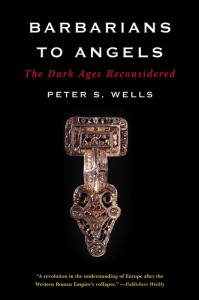 Barbarians to Angels: The Dark Ages Reconsidered by Peter S. Wells
Barbarians to Angels: The Dark Ages Reconsidered by Peter S. Wells
2008, W. W. Norton & Company
204 pages
I’ve always pined for the Dark Ages of Northern Europe, and never been able to justify it – let’s face it, the “barbarian” tribes have been brought into thorough disrepute by the dour Roman commentators of the late Empire. What a pleasure, then, to discover a book that dismantles those jaded opinions with wit and clarity.
Peter Wells is a prominent archaeologist, and in this book he presents – in a fascinating and very readable way – an argument that the Dark Age German and Celtic groups were actually cosmopolitan, creative, innovative, and worldly. The basis of his argument: rather than relying on Roman opinion he relies on the actual archaeological evidence left behind by the supposed barbarians.
The archaeological evidence – settlement ruins, burial finds, sacrificial finds, and so forth, reveals peoples who were anything but backward. They created exquisite new art forms, opened up expansive trade networks (strongly disconfirming the notion that the old Heathens were somehow hermetically sealed from other cultures), and lived largely peaceful lives despite living in a time of great (but, argues Wells, much more gradual than previously understood) change.
Wells’ writing is crisp and bracing and his obvious enthusiasm for the minutiae of archaeological finds is infectious. This book is a powerful antithesis to the dry excesses of so many history texts.
Wells also puts some dents in the notion that premodern Europeans had terrible nutrition and dental health. Actual examination of some of the bodies from this period show that in life they seem likely to have been well fed and had good teeth. I must admit my distrust of the triumphalism of modern medicine is rather fuelled by such findings.
Indeed, the only real flaw in this book is that Wells seems to gently argue that the Dark Ages peoples should be celebrated as a stepping stone to Charlemagne and modernity – as opposed to simply appreciating their achievements on their own terms.
He also fails to reflect on the extent of the violence and cruelty that Charlemagne utilised to consolidate his Christian powerbase – Wells is right to point out that the conversion was less sudden and simple than some folk would like to think, but I think he leans too far the other way in the process. On the other hand, he does make the important point that many pagan traditions lived on quite happily after the conversion.
On the whole, and despite my ultimately very minimal criticisms, it is deeply refreshing to read such a thorough, detailed, and thoughtful book about European history. Wells grasps both the importance of details and the importance of the big picture, and on the whole this book is a must-read for anyone who has an interest in Northern European history.
There are many brilliant quotes throughout the book but I think I might end on this very thought provoking question that Wells poses on page 201:
“[W]hich people drive change? Is change brought about largely through the actions of leaders, or by the majority of people? To read traditional text-based history of the first millennium, we could think that the persons named in the texts were the decisive factors – emperors such as Constantine and Julian, Germanic leaders such as Alaric and Clovis, other barbarian rulers such as Attila. These individuals and their actions were the subjects of the writers’ attention; hence they form the focus of the textual accounts. But battles were won by armies, not by generals. Surplus production by farms in villages all over Europe enables the thriving trade in amber and glass beads, grindstones, fine pottery and glassware, and other desirable goods. Growth in manufacturing at centres such as Helgö and Southampton, and at inland settlements such as Mayen, fuelled the desire for manufactured goods and trade items throughout Europe. Expansion of specialised industries, such as that in pottery in the middle Rhineland, had no obvious elite component as a driving force. So which group played the greater role in causing the changes during these centuries – the elites or the majority of the people?”
You’ll have to buy the book if you hope to be able to venture an informed answer to this question…









Leave a Reply